![]()
![]()
![]()
Use LEFT and RIGHT arrow keys to navigate between flashcards;
Use UP and DOWN arrow keys to flip the card;
H to show hint;
A reads text to speech;
32 Cards in this Set
- Front
- Back
|
Waves |
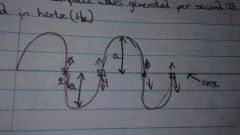
The two types are: transverse and longitudinal. |
|
|
Transverse waves |
These waves travel at 90° to the source. Examples: water waves & EM spectrum. |
|
|
Longitudinal waves |

These waves travel parallel to the source in a series of compressions (c) and raregacrions (r). |
|
|
Wavelength |
The distance from crest to crest or trough to trough. It is measured in lambda(Y). Equation: Wavelength= speed/ frequency Y=v/f |
|
|
Frequency(f) |
The number of complete waves generated per second. Frequency= 1/Time f=1/T |
|
|
Period (T) |
This is the time taken for one wave to be generated. Period= 1/frequency T=1/f |
|
|
Speed (v) |
This is the distance of movement of any part of the wave in one second. Speed=frequency*wavelength v=fY |
|
|
Amplitude |
The height from rest to crest or rest to trough. |
|
|
Reflection |
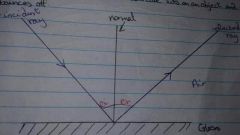
This is the process by which a wave hits an object and bounces off. The normal is always perpendicular to the surface. |
|
|
Refraction |

This is when waves move through a material and bends |
|
|
Diffraction |

The spreading of waves at the edges of obstacles. |
|
|
Interference |
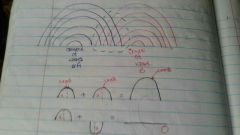
This occurs when 2 waves cross paths |
|
|
Newton's Laws |
First law: a body at rest stays at rest unless a force it applies to it and a body travelling in a straight line continues to move in that direction unless is force is applied to it. Second law: the net force on a body is equal to the product of its mass and acceleration. Equation: F=am Third law: for every act there is is opposite and equal reaction. |
|
|
Archimedes Law |
When a body is partially or totally submerged in a fluid it experiences an upthrust which is equal or opposite to the weight of the fluid displaced. |
|
|
Density(e) |
It is mass per unit volume. It is measured in kgm-3 or gcm-3. e=m/v m=ev v=m/e |
|
|
Relative Density |
This is the density of a substance in relation to another substance or water. It has no units. RD=esubstance/ewater RD=mass substance/mass water. |
|
|
Pressure |
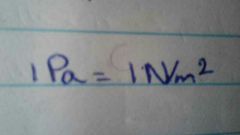
Pressure=force/area P=F/A It is measured in pascals(Pa). In liquids:P=egh |
|
|
SI Units and Base Quantities |
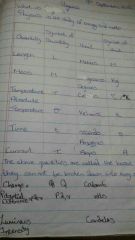
|
|
|
Prefix |
Tera(T)- x10^12 Giga (G)- x10^9 Mega (M)- x10^6 Kilo (K)-×10^3 Deca (d)- x10^1 Centi (C)- ÷10^2 Milli (m)-÷10^3 Micro (u)-÷10^6 Nano (n)-÷10^9 Pico (p)-÷10^12 |
|
|
Boyle's Law |
The pressure of a fixed mass of gas at constant temperature. Equation: P~1/V; T and n constant |
|
|
Charle's law |
The volume of a fixed mass of gas. It is directly proportional to its absolute temperature (T) if pressure (P) remains constant. Equation: V~T V1÷T1=V2÷T2 |
|
|
Guy Lussac's Law |
The pressure of a fixed mass of gas is directly proportional to its absolute temperature if the volume remains constant. Equation: P1÷T1=P2÷T2 |
|
|
P1V1/T1=P2V2/T2 |
When a gas goes from one state to another. |
|
|
Specific Heat Capacity (SHC) |
This is the thirst of a substance for hear. It is measured in JKgK-1. E=m◇●c m- mass ◇●- temperature change c- SHC |
|
|
To change Celsius to Kelvin |
Add 273 |
|
|
Evaporation |
This type of vaporization occurs only at the surface and it occurs below the boiling point. |
|
|
Boiling |
This occurs through the liquid and it also occurs at the boiling point. |
|
|
Conduction |
This is the flow of heat through matter by direct contact and with out movement of the matter as a whole. E.g. pan on stove. |
|
|
Convection |
This is the flow of heat through fluid from places of Higher to places of lower temperature by movement of the fluid itself. E.g. water just before it boil by convection currents |
|
|
Radiation |
This is the flow of heat from one place to another by means of waves.E g. heat from sun, Bond fire and laptop |
|
|
Moments |
A moment is a turning Force. There is no resultant force. It is measured in Newton metres. For moments to occur the force must be perpendicular to the pivot. Moment=force*distance |
|
|
Law of Moments |
The sum of clockwise moments equal to the sum of anticlockwise moments |

